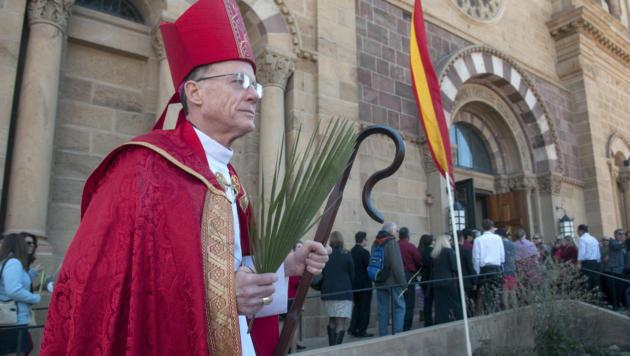|
Guest Column: Archdiocese committed to righting wrongs
By John C. Wester
[See also the Santa Fe archdiocesan list of accused perpetrators. It includes more than 20 persons not previously known to be accused. See BishopAccountability.org's webpage about the Lists of Accused Priests Released by Dioceses and Religious Institutes for more information.] My Dear Brothers and Sisters in Christ, On Sept. 12 the Archdiocese of Santa Fe released a list of 74 priests, deacons and religious who have been accused of sexual abuse of children. The vast majority of these abuses occurred over 25 years ago. Since then, the Archdiocese of Santa Fe has implemented a number of strict measures, including removing perpetrators from ministry, terminating employment of perpetrators, instituting a zero tolerance policy, and implementing Safe Environment and Victim’s Assistance Programs throughout the Archdiocese. As a result, since 1993 the Archdiocese has received only two reports of clergy sexual misconduct with a minor where the incident was reported to have occurred later than 1993. On Oct. 18, Judge Alan Malott, a district court judge in Albuquerque, ordered the public release of approximately 1,000 pages of documents related to three of the most prolific child abusers to have ever served in the Archdiocese of Santa Fe: Arthur Perrault, Sabine Griego and Jason Sigler. Although their crimes were committed decades ago, it is my hope that the release of these documents to the public will further aid in the healing process for past victims and their families. It is difficult to put into words my sadness and shame over the betrayal of trust by members of the clergy who were supposed to love and protect our children and young people, and for the pain and suffering endured by victims of this abuse. I offer my sincere apology on behalf of the Archdiocese to survivors and their families and my continued commitment to support and assist you on your road to healing and recovery. Jesus said “Let the children come to me and do not prevent them; for the kingdom of God belongs to such as these” (Lk 18:16). It is at the heart of the church’s mission, therefore, to protect, nurture and care for our children. Indeed, the church and any society can be judged on how well it cares for the vulnerable in its midst. When the church fails in this sacred responsibility, we betray the trust Christ has given us and the trust of those we have a responsibility to look out for and safeguard. I firmly believe that actions speak louder than words. What is often lost or relegated to a footnote in the media’s coverage of the clergy sexual abuse crisis in New Mexico are the many steps this Archdiocese has taken over the past 25 years to prevent sexual abuse of children. First of all, since 1993, the Archdiocese has adopted a “zero tolerance” policy with respect to clergy credibly accused of sexual misconduct with minors. Of the 74 names on the Archdiocese’s list of accused clergy, those who are still living have been permanently restricted from public ministry or removed from the priesthood. Moreover, the Archdiocese continues to expand and develop its Victim’s Assistance and Safe Environment Programs. The Archdiocese requires that all clergy, employees and volunteers undergo criminal background checks and attend workshops on recognizing and reporting signs that a child may be the victim of physical or sexual abuse or harassment. Seminary candidates for the Archdiocese also undergo extensive psychological testing and screening as a prerequisite to admission, followed by continuing evaluation and support. All clergy must participate in ongoing sexual abuse awareness and prevention training every five years. The Archdiocese’s programs include, but are not limited to, providing counseling to victims of clergy sexual abuse at the expense of the Archdiocese, conducting annual children and youth protection classes at every grade level in the Catholic school system as well as in parish-based religious education programs for those who are not enrolled in Catholic schools. These programs also reinforce appropriate boundaries that must be adhered to when adults interact with children and young people. In addition, the Archdiocese has established an Independent Review Board (IRB), headed by a retired district court judge and composed of lay professionals in the fields of medicine, psychology, social work, civil law and/or canon law, a member of the clergy and members of the church-at-large. The IRB serves as a confidential consultative body to the archbishop and its primary function is to advise the archbishop in his assessment of allegations of sexual abuse of minors and his determination of suitability for ministry of those accused. Additionally, each year the Archdiocese participates in an independent audit conducted by the United States Conference of Catholic Bishops to measure compliance with the guidelines of the national Charter for the Protection of Children and Young People. The Archdiocese is also continuously working to identify additional ways that we can aid in the healing process. Following the example of my predecessor, Archbishop Emeritus Michael J. Sheehan, I continue to personally meet with and apologize to victims of clergy sexual misconduct. Beginning in November and continuing into January 2018, the Archdiocese will conduct panel discussions on clergy sexual abuse at various parishes throughout the Archdiocese. Our goal in hosting these discussions is to promote further transparency and healing, to open the lines of communication with the Catholic faithful and our communities, and to hopefully obtain additional ideas on how to better promote healing and prevent childhood sexual abuse in the future.
|
.
Any original material on these pages is copyright © BishopAccountability.org 2004. Reproduce freely with attribution.
